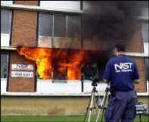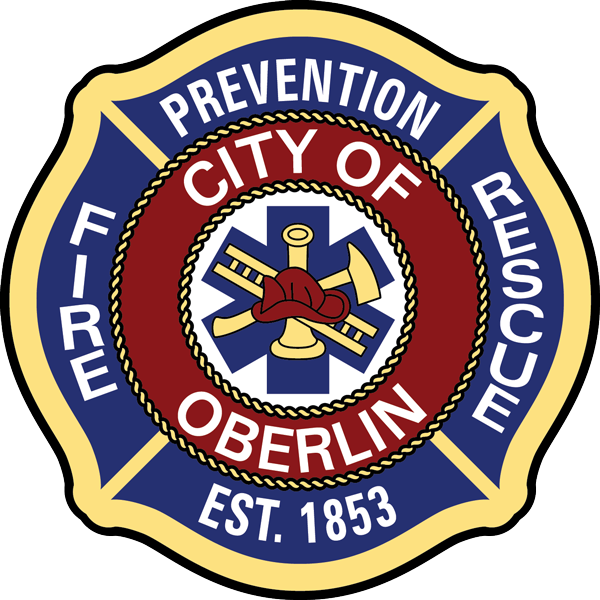College Fire Safety
Campus fire safety is a serious concern. According to data since 2000, over 169 fatalities have occurred in dormitories and residential housing fires. Tragic fires at Ohio University, Ohio State, Seton Hall, Chapel Hill, Bloomsburg, and other universities and colleges have brought a new awareness to the importance of fire safety in student housing. Further, the U.S. Department of Education estimates that two-thirds of students enrolled in four-year institutions live off-campus. Unfortunately, Ohio lead the nation with the largest loss of students at 14. Data on fatalities is broken down as follows:
|
Occupancies |
Fatalities |
|
| Off-campus |
146 |
87% |
| On-campus | 10 | 6% |
| Greek | 10 | 6% |
| Other | 2 | 1% |
| TOTAL | 169 | |
The photo (right) shows a controlled dormitory room fire monitored by the National Institute of Standards and Technology. NIST conducted a series of fire experiments in Fulbright Hall at the University of Arkansas campus as part of a U.S. Fire Administration initiative to improve fire safety in college housing.
NIST conducted a series of fire experiments in Fulbright Hall at the University of Arkansas campus as part of a U.S. Fire Administration initiative to improve fire safety in college housing.
The Oberlin Fire Department and the United States Fire Administration (USFA) offers these tips to help reduce and prevent the loss of life and property in dormitory and off-campus housing fires.
The Facts
In cases where fire fatalities occurred on college campuses, alcohol was a factor. There is a strong link between alcohol and fire deaths. In more than 50% of adult fire fatalities, victims were under the influence at the time of the fire. Alcohol abuse often impairs judgment and hampers evacuation efforts. Cooking is the leading cause of fire injuries on college campuses, closely followed by careless smoking and arson.
The consequences of fires in residence halls, dormitories or rooming houses are the same as those associated with any occupancy: property damage, loss of personal possessions, injuries, and deaths.
The Causes
Many factors contribute to the problem of student housing fires.
* Improper use of 911 notification systems delays emergency response.
* Student apathy is prevalent. Many are unaware that fire is a risk or threat in the environment.
* Evacuation efforts are hindered since fire alarms are often ignored.
* Building evacuations are delayed due to lack of preparation and preplanning.
* Vandalized and improperly maintained smoke alarms and fire alarm systems inhibit early detection of fires.
* Misuse of cooking appliances, overloaded electrical circuits and extension cords increase the risk of fires.
What were some specific causes? Let’s look back at a few incidents:
|
DATE |
CAUSE |
RESULTS |
| Oct 31, 2014 |
Off-campus fire – Western Ky University |
1 dead |
| Apr 24, 2014 | Off-campus fire – Purdue University West Lafayette IN Cause: under investigation |
1 dead |
| Mar 16, 2014 | Off-campus fire – Univ of North Dakota Grand Forks ND Cause: unattended cooking |
1 dead |
| Feb 4, 2014 | Off-campus fire – Frostburg State Univ Frostburg, MD Cause: undetermined |
1 dead |
| Nov 17, 2013 | Off-campus fire – Purdue University West Layfayette, IN Cause: undetermined |
1 dead |
| Apr 28, 2013 | Off-campus fire – Boston University Boston, MA Cause: smoking |
1 dead |
| Jan 21, 2013 | Off-campus fire – Univ of Massachusetts Amherst, MA Cause: undetermined |
1 dead |
| Jan 1, 2013 | Off-campus fire – University of Cincinnati Cincinnati, OH Cause: space heater |
1 dead |
| Nov 24, 2012 | Off-campus fire – St Cloud University St Cloud, MN Cause: undetermined |
1 dead |
| Oct 8, 2012 | Off-campus fire – Univ of Wisconsin Eau Claire, WI Cause: undetermined |
2 dead |
| Jan 21, 2012 | Off-campus fire – Marist college Poughkeepsie, NY Cause: undetermined |
3 dead |
| Oct 20, 2011 | Off-campus fire – Emporia State Univ Emporia, KS Cause: combustibles near heater |
2 dead |
| Jan 30, 2010 | Off-campus fire – W State Coll of Colorado | 2 dead |
| Jan 23, 2009 | Off-campus fire – Intl Business College |
3 dead |
| Apr 5, 2008 | Off-campus fire – Univ of Wisconsin | 3 dead |
| Nov 8, 2007 | Off-campus fire – Rochester Inst of Tech | 2 dead |
| Oct 28, 2007 | Off-campus fire – Univ of South Carolina | 7 dead |
| April 30, 2007 | Off-campus fire – Univ of Pittsburgh, PA Cause: accidental |
1 dead |
Safety Tips
Fire Code Requirements in Campus Residences:
All on-campus residence facilities are inspected at least twice annually by the City of Oberlin Fire Department and College representatives. All campus facilities are subject to the code requirements of the Ohio Building Code, Oberlin Fire Prevention Code, and City of Oberlin Property Maintenance codes. Annual inspections and testing are conducted by state certified contractors to assure proper operation of all fire alarm, detection, and suppression systems.
Oberlin College has incorporated state-of-the-art fire detection systems in all campus residence facilities. On-campus residents may be assured that these systems are tested in accordance with fire code regulations and are constantly maintained. All fire protection systems are directly linked both to Oberlin College Safety & Security and monitored by the City of Oberlin Fire Department. All alarm activations receive an immediate response from both agencies. Many hallway and stairway doors are equipped to automatically close to protect occupants whenever a fire alarm is activated. Many of the kitchenette facilities furnished in the residence halls are protected by automatic fire suppression systems. Fire extinguishers are conveniently located throughout the buildings.
Fire Code Requirements in Off-Campus Residences:
Off-campus residences are subject to City inspections. Owners or managers of rental properties are required to have their property inspected for violations of the City Property Maintenance Code at the time of occupancy change (new tenant), at the change of ownership, or at the request of the current tenant. Other occupancies classified as rooming houses require an annual inspection and license by the City of Oberlin. These facilities are subject to the provisions of the Ohio Building Code, Oberlin Fire Prevention Code, and City Property Maintenance codes, in addition to specific local fire safety requirements.
What is a rooming house? By City ordinance, a rooming house is any rental property that is occupied by five or more unrelated tenants. Special local fire safety code requirements for rooming houses include:
1. Second means of egress (stairway) for all occupants living on the second and/or third floors.
2. Interconnected smoke detector system, allowing immediate warning to all occupants on all floors.
Students also have rights and protections. Section 5321.04(A)(1) of the Ohio Revised Code (Ohio Landlord Tenant Act) notes that a landlord who is a party to a rental agreement shall … “comply with the requirements of all applicable building, housing, health, and safety codes that materially affect health and safety”. See the Ohio Landlord Tenant Act.
